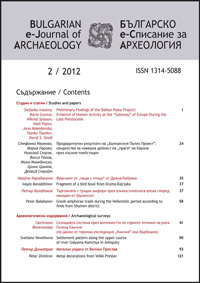Бронзова куха брадва от Хасковско
A bronze socketed axe from the region of Haskovo
Author(s): Georgi Nehrizov, Silvia Ivanova, Deyan LesigyarskiSubject(s): Archaeology
Published by: Асоциация на българските археолози
Summary/Abstract: Object of analysis in this paper is a socketed axe (‘celt’) which is a stray find from the region of the village Knizhovnik, south of Haskovo. As reported by D. Aladzhov there is an Early Iron Age settlement in this area. The artefact belongs to type Varbitsa T1A after the typology of Lower Danubian socketed axes offered by V. Dergachev. This type is common for the central parts of Northern Bulgaria, west of the Yantra River. That kind of ‘celt’ is predominantly found in hoards of the HaA-HaB period. The stray find from the region of Haskovo is among the smallest tools of this type and probably dates to the X-IX century BC or the first phase of the Early Iron Age in Bulgaria. It is important to take into consideration that it is the only representative of type Varbitsa T1A south of the Balkan mountains. However, the moulds for production of this type of socketed axes are from South Bulgaria. The chemical composition of the ‘celt’ (As, Cu, Fe, Mn, Ni, P, Pb, Sb, Se, Sn, and Zn) has been determined by inductively coupled plasma atomic emission spectroscopy (ICP-AES). The artefact is made of tin bronze with 93,15 % copper and 3,3 % tin. Such concentration of tin is common for archaeological bronze finds, it lowers the melting point of the alloy and improves its malleability, hardness and tensile strength. The quantity of antimony is 1,6 % which is an evidence that the element was deliberately added to increase the hardness of the metal. The concentrations of trace elements such as zinc, nickel, lead, iron, arsenic, phosphorus, manganese and selenium are so low that it could not be suggested that they have been intentionally included in the alloy. In general, ‘celts’ are usually made of tin bronze in bivalve stone moulds. A socketed axe from Northeast Bulgaria was examined by the methods of metallography. The revealed production technique is casting which was followed by a cycle or cycles of cold hammering and annealing with annealing as final operation.
Journal: Българско е-Списание за Археология
- Issue Year: 2/2012
- Issue No: 1
- Page Range: 73-78
- Page Count: 6
- Language: Bulgarian

